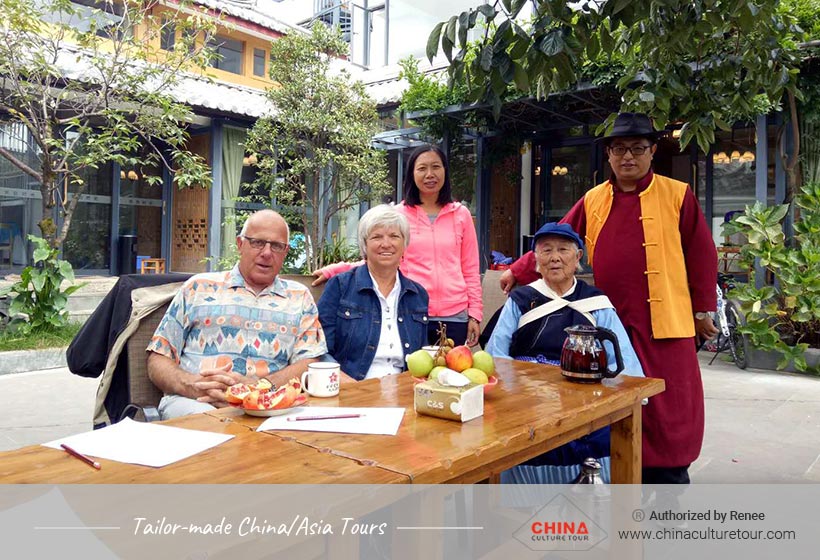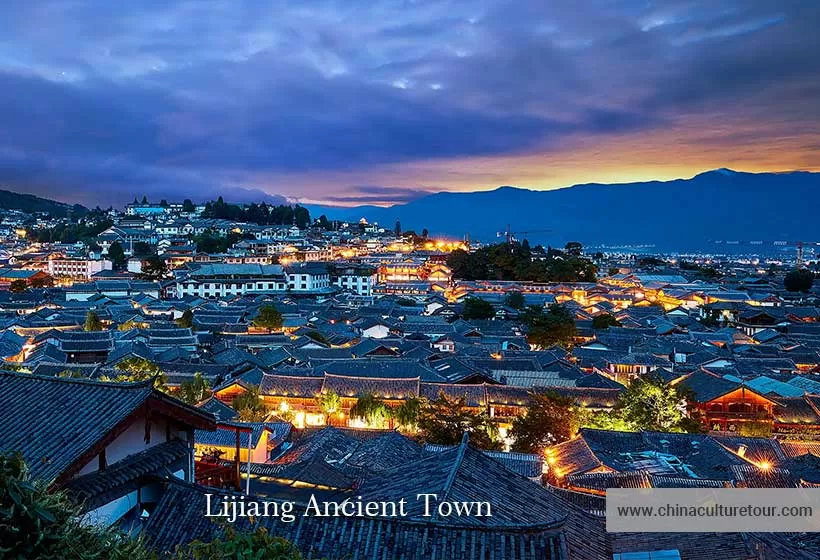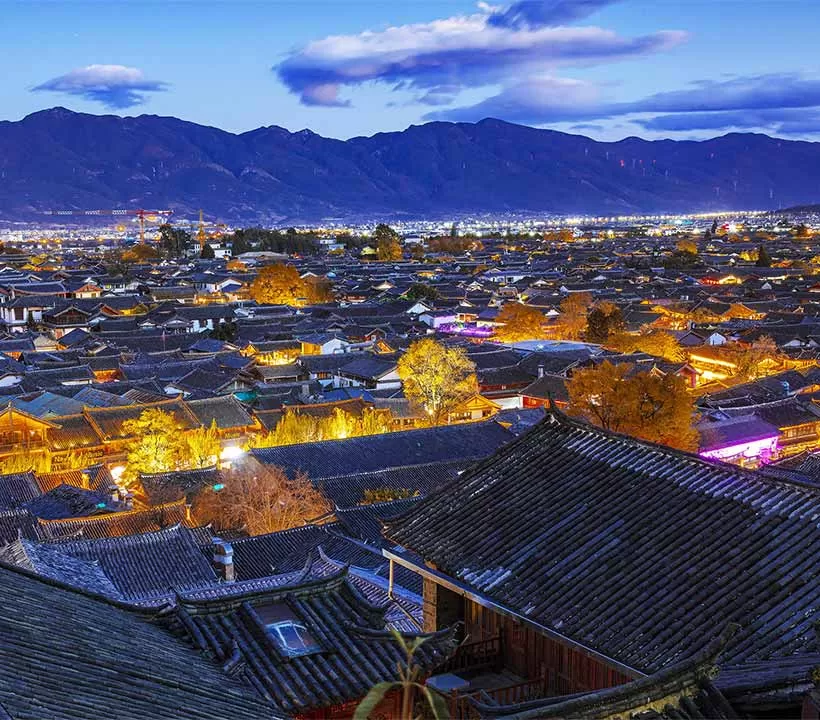Short Introduction to Lijiang Local Culture: History, Nation, Diet, Clothing, etc
Lijiang is an internationally renowned tourist city and a national historical and cultural city, serving as an important passage on the ancient "Southern Silk Road" and the "Tea Horse Road". It is a multi-ethnic region where, in addition to the Han, there are 12 indigenous ethnic minorities and 22 minority groups in city. Each ethnic group has its own unique festivals, dance, folk songs and culture. Such as Nakhi (Naxi), The Nakhi people are renowned for their splendid Dongba Culture which is characterized with a mixture of Tibet culture and Han culture. In Lijiang you’ll be able to access various souvenirs of Dongba culture.
Brief History
As early as 100,000 years ago, during the late Paleolithic period, Homo sapiens (Lijiang people) were already present in the region. During the Warring States period, it was part of the Qin state's Shu Commandery. In the Three Kingdoms period, it belonged to the Yunnan Commandery. During the Jin and Northern and Southern Dynasties, Lijiang was still part of Yunnan Commandery and was known as Suijiu County. It was around this time that the ancestors of the Naxi people migrated to the area.
In the Southern Song Dynasty (1285), the Lijiang Xuanfu Office was established, marking the beginning of the Mu family's rule.
During the Ming Dynasty, the Tusi system brought the first period of prosperity to Lijiang Old Town. Lijiang was a key passage for the ancient "Southern Silk Road" and the "Chuan-Dian-Tibet Tea Horse Road," serving as an important trade route and cultural bridge. It flourished in the Tang and Song dynasties and reached its peak during the Ming and Qing dynasties.
In the 35th year of the Qianlong reign (1770), Lijiang County was established, and Lijiang Old Town became a major transportation hub and commercial center in Yunnan Province.
In July 1949, Lijiang County was liberated and came under the jurisdiction of the Northwest Yunnan People's Commissioner’s Office.
On December 26, 2002, Lijiang was upgraded from a regional administrative area to a city, with the former Lijiang area renamed Lijiang City, and the former Lijiang Naxi Autonomous County divided into Lijiang Old Town and Yulong Naxi Autonomous County.
Ethnic Culture
Lijiang is a region where multiple ethnic groups reside. Besides the Han majority, there are minority ethnic groups including Naxi, Yi, Lisu, Bai, Dai, Miao, and Hui, making up 55.8% of the total population. Each of these ethnic groups has its own unique culture and traditions. These diverse cultures and traditions intermingle and influence each other, creating a unique cultural atmosphere and landscape that make Lijiang a vibrant and charming tourist destination.
The Naxi people are one of the oldest ethnic groups in the Lijiang region, with a rich and unique cultural history. Known for their love of music and dance, "Naxi Ancient Music” is world-renowned. They have preserved the complete Dongba culture, which gives them a unique charm.
Mouso people who lives near the Lugu lake in Lijiang, China’s only surviving matriarchal society, often referred to as the "Kingdom of Daughters." They have a unique "walking marriage" tradition, where individuals freely choose partners at special bonfire parties. If they are interested in each other, the man will hang his hat outside the woman's door and climb into her room at night. He leaves alone during the day, and the elders of both parties meet to conduct a small ceremony. During the day, the man lives with his mother, while at night he stays at the home of the woman, If the woman pregnant, the man does not need to provide financial support, only prepare gifts for the child during festivals and holidays.
Ethnic Minority Clothes of Lijiang
Naxi men wear short jackets with long pants and a small felt hat decorated with pheasant feathers. Naxi women's attire typically features a base of blue or black fabric paired with red or blue accents. They wear long, knee-length, wide-sleeved robes with a vest, a pleated waist sash, long pants, and a sheepskin shawl. During festivals, They don a shawls with sun,moon, and seven-star embroidery pattens, symbolizing the diligence, bravery, and virtues of Naxi women.
Ethnic Language
The Han Chinese dialect of Yunnan (also known as Yunnanese) is the most widely spoken language. In Lijiang, the Naxi language belongs to the Tibeto-Burman branch of the Sino-Tibetan language family. The Naxi people have their own language and script, the Dongba script, which is known as the "only living pictographic writing system in the world." The Dongba script and Dongba murals reflect the wisdom and creativity of the Naxi people.
Festival of Ethnic
Jitian: (Feb)The Jitian, or "Heaven Worship Ceremony," is one of the most significant rituals in Naxi Dongba religion and is also the largest traditional festival among the Naxi people. It is held during the first month of the lunar calendar.
Bangbang Festival: (Jan 15th) This is an important cultural activity of the Nakhi people. On the fifteenth day of the first lunar month, in addition to customs similar to the Han people, such as eating yuanxiao (glutinous rice dumplings) and viewing lanterns, there are also activities with distinct local ethnic characteristics.
Sanduo Festival: (Feb 8th) On the eighth day of the second lunar month, a festival with over 1,200 years of history is celebrated, which has been listed as a national intangible cultural heritage. It is one of the most important traditional festivals for the Naxi people. They dress in their finest attire and participate in activities such as traditional dancing, showcasing the ancient and rich Nakhi culture.
Torch Festival: (June 24th) It is celebrated on the 24th or 25th day of the sixth month of the Yi calendar, the Yi people celebrate the festival to eradicate insect swarms and celebrate a good harvest, they wear festival suits, play Yu-kin musical instruments and the great three-stringed instrument to participate in Torch Festival.
Spring Festival: (Feb 10th) During the Spring Festival, known in Lijiang as "You Ben Ji Zheng" or "Ku Shi," which means New Year, the Nakhi people celebrate with various customs. They place camellia flowers in vases, put up spring couplets and door gods, and prepare a variety of dishes, fruits, and offerings. They also worship the "Kitchen God" and welcome their ancestor’s "home" to celebrate the New Year.
Diet Style and Culinary Tastes
Lijiang's cuisine is a delightful blend of Nakhi, Tibetan, and Yunnan flavors, offering unique dishes such as Nakhi Pickled sour fish,Crossing the Bridge Rice Noodles, and baba, a type of local flatbread. The vibrant food markets and traditional restaurants provide a rich culinary experience that reflects the region's diverse cultural heritage.
Cultural Heritage
Lijiang is a city with over 800 years of history and is a UNESCO World Heritage Site. The ancient town is renowned not only for its unique Naxi culture and well-preserved historic architecture but also for its distinctive natural landscapes and cultural attractions. Lijiang is the only prefecture-level city in China that boasts three UNESCO World Heritage sites simultaneously.
In 2003, the Dongba ancient texts of Lijiang were included in the UNESCO Memory of the World Register. The Dongba pictographic script is acclaimed as the "only living pictographic writing system in the world."
In July 2003, the unique natural geographical phenomenon where the Jinsha River, Lancang River, and Nujiang River flow side by side without merging was listed as a World.
National Intangible Cultural Heritage includes: Naxi Dongba paintings, Naxi folk dance and song "Remi Cuo," the Naxi classical music suite "Baisha Xiyue," Yongsheng enamel silverware crafting skills, Pumi people's Niandazefeng Mountain Ritual, Naxi traditional festival Sanduo Festival, and Naxi children's rhymes.
Taboos
The Naxi people have a strong taboo against riding horses in front of their village; one must dismount before arriving. Additionally, it is forbidden to tie horses at the place where ceremonies for heaven are held.
The Naxi people have specific taboos related to their religious practices
During ceremonies for heaven, ancestors, or war gods, it is forbidden for outsiders to observe.
One must not touch or step on religious symbols to maintain the dignity of their beliefs. It is prohibited to cross over the triangular frame on the fire pit, or to step on it or place shoes, socks, or clothing on it.
Customize Your Unique Lijiang Tour
If you are interested in one of the Lijiang itineraries mentioned above, please contact us, and we will be happy to customize it and provide a quote tailored to your preferences.
Alternatively, if you would like to customize your Lijiang Tour, please visit our Lijiang Tour Customized Center. We assure you that you will receive a reply within 24 working hours.
Informative Articles for Your Lijiang Trip
 Naxi Ethnic in Lijiang
Naxi Ethnic in Lijiang- Travel Guide: attractions, seasons, hotels, food, itineraries, etc.
- Top destinations: places to visit in Lijaing
- Travel itineraries: best itineraries for your reference
- Weather: the best time and seasons to visit Lijaing
- Top attractions:well-selected top attractions in Lijaing
- Cultural immersions: hands-on activities to spotlight your trip
- Unique perspective: top different things to do
- Local food: what to eat while traveling in Lijaing
- Luxury hotels: where to stay in Lijaing
- Lijiang Tours: tailor-made Lijiang Tours for your reference
GREAT FAMILY CHINA TOUR
JULY 2024 We wanted to thank Grace at China Culture tour for organizing a great tour of China. We enjoyed our Beijing - Xian-Chengdu -Guilin -Yangshuo - Shanghai trip. Our local guides Bruce in Beijing, Susan in Xian, Jane in Chengdu, Mike in Guilin and Mary in Shanghai took care of us…read more details »
Teng Han L from SINGAPORE
Ready to Create a Unique Dream Travel?



